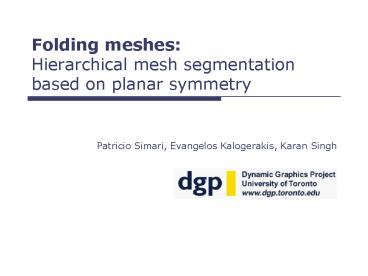Folding meshes: Hierarchical mesh segmentation based on planar symmetry - PowerPoint PPT Presentation
Title:
Folding meshes: Hierarchical mesh segmentation based on planar symmetry
Description:
Title: Folding meshes: Hierarchical mesh segmentation based on planar symmetry Author: Patricio Simari Last modified by: Patricio Simari Created Date – PowerPoint PPT presentation
Number of Views:125
Avg rating:3.0/5.0
Title: Folding meshes: Hierarchical mesh segmentation based on planar symmetry
1
Folding meshes Hierarchical mesh segmentation
based on planar symmetry
- Patricio Simari, Evangelos Kalogerakis, Karan
Singh
2
Introduction and motivation
- Meshes may contain a high level of redundancy due
to symmetry, either global or localized. - We propose an algorithm for detecting approximate
planar reflective symmetry globally and locally. - Applications include
- Compression
- Segmentation
- Repair
- Skeleton Extraction
- Mesh processing acceleration
3
Related work
- Perfect in polygons and polyhedra Atallah 85,
Wolter et al. 85, Highnam 86, Jiang Bunke
96. - Approximate in point sets Alt et al. 88.
- 2D images/range images Marola 89, Gofman
Kiryati 96, Shen et al. 99, Zabrodsky et al.
95. - Global 3D OMara Owens 96, Sun Sherrah 97,
Sun Si 99, Martinet et al. 05. - Global as shape desc. Kazhdan et al. 04.
- Local 3D Thrun Wegbreit 05, Podolak et al.
06, Mitra et al. 06.
4
Overview
- Property A symmetric surfaces planes of
symmetry are orthogonal to the eigenvectors of
its covariance matrix and contain its centre of
mass. - Leverage this fact iteratively re-weighted least
squares (IRLS) approach with M-estimation to
converge to a locally symmetric region.
5
Solving for plane of symmetry
- Consider a candidate symmetry plane p and let di
be the distance of vertex vi to the reflected
mesh wrt p. - Each vi is associated a weight wi according to
6
Solving for plane of symmetry
- The plane of symmetry is estimated by the centre
of mass m and the eigenvectors of the weighted
covariance matrix C defined as
- These eigenvectors and centre of mass determine
three planes. - One with smallest sum cost is chosen.
7
Support region motivation
8
Controlling leverage
9
Controlling leverage
10
Controlling leverage
11
Controlling leverage
12
Controlling leverage
13
Finding support region
- Given the current ? values we consider a face to
be a support face if for all of its vertices di
2s. Hampel et al. 86 - We find the largest connected region of support
faces, and set weights for all vertices outside
this region to 0. - The plane finding and region finding steps are
iterated until convergence.
14
Initialization
- Initially, wi is defined to be the mesh area
associated with vertex vi - The initial support regions contains all faces.
- s 1.4826median(di) Forsyth and Ponce 02
during initial iterations and then is fixed to
2e.
15
Convergence
16
Convergence
17
Convergence
18
Convergence
19
Convergence
20
Convergence
21
Convergence
22
Finding other local symmetries
- Converge to symmetric region
- Segment out locally symmetric region
- Apply recursively to one half of the symmetric
region (nested symmetries) and to each remaining
connected component.
23
Results Local symmetry detection
24
Results Local symmetry detection
25
Results Local symmetry detection
26
Folding trees
- We introduce the folding tree data structure.
- Encodes the non redundant regions as well as the
reflection planes. - Created by recursive application of the detection
method. - Can then be unfolded to recover the original
shape.
27
Folding tree example
28
Results Folding trees
29
Results Folding trees
30
Results Folding trees
31
Results Folding trees
32
Results Folding trees
33
Conclusions
- We have presented a robust estimation approach to
finding global as well as local planar
symmetries. - We have introduced a compact representation of
meshes, called folding trees, and shown how they
can be automatically constructed using the
detection method.
34
Future work
- Investigation alternate initialization schemes
- Extension to translational and rotational
symmetries - Exploration of other applications
- Repair
- Robust skeleton extraction
- Shape description/retrieval































